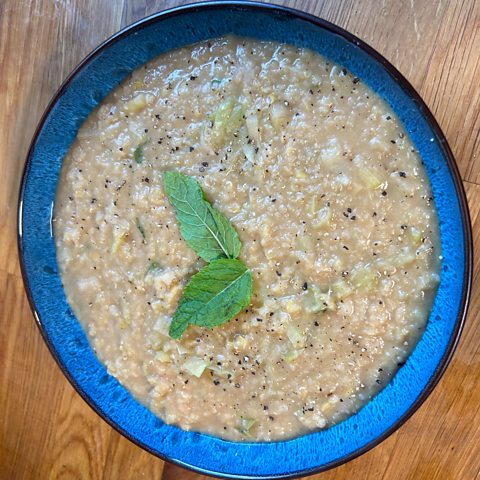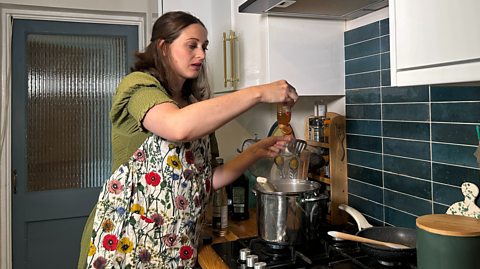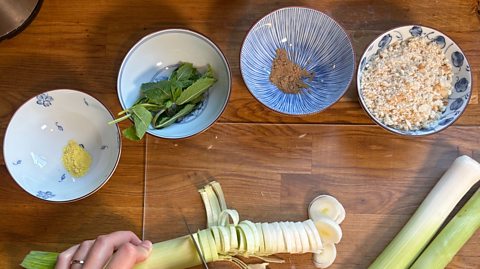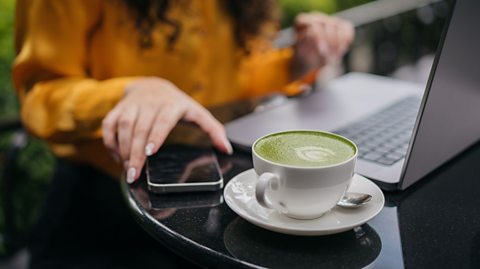Do you have a favourite recipe that has been passed down to you? Maybe itâs a recipe that can be traced through your family history or simply something your friend made that you just had to recreate.
What if we handed you a 2,000 year old recipe, would you want to try making that?
If you are up for the challenge, 91ČČąŽ Bitesize has you covered. Dr Eleanor Barnett from Cardiff University is a food historian who uses social media to share daily posts all about food history and she handed us a lentil stew recipe that dates back to ancient Roman times.
 Image source, Dr Eleanor Barnett
Image source, Dr Eleanor BarnettWhat did recipes look like?
Recipes have changed over time and werenât always presented in books that you would proudly place on your kitchen shelf. For thousands of years, many people couldnât read or write so they didnât jot down the recipes they were following. And when recipes did begin to be recorded, they certainly didnât look like they do today.
Dr Eleanor revealed that, âSome medieval recipes say things like âcook for as long as it takes to say the Lordâs Prayer', because that was so common in their daily lives. They certainly didnât use weights and measures, itâs much more about what you had available.â
The 19th century Victorian era was when recipes started being more directional and something a modern audiences can follow more easily. Dr Eleanor referred to Mrs Beeton, a famous Victorian household name who wrote Mrs. Beeton's Book of Household Management, adding: âThis is when you start to see things like âserves X amount of peopleâ and she even included the cost of ingredients.â
Where did this recipe come from?
The lentil stew recipe that Dr Eleanor has provided is taken from Apicius, also known as De Re Coquinaria or The Art of Cooking, the oldest collection of recipes surviving from ancient Rome. Nobody is too sure who the author of the collection is, but Dr Eleanor has a theory, saying: âItâs well known that it was named after Marcus Gavius Apicius who was known for being very someone who is greedy, especially when it comes to food. He travelled from Campania to Libya looking for the largest, juiciest prawns he could get.â However, Dr Eleanor also believes that in reality, itâs not Marcusâ book but rather a collection of recipes that were brought together over time by someone whose job was to copy documents before printing was invented.
Apicius is full of extravagant meals and ingredients including flamingo, which was an exotic ingredient in ancient Rome. Dr Eleanor told us: âI chose the lentil recipe because I think itâs genuinely delicious and we recognise it enough that itâs not too strange, but at the same time, itâs got some interesting ingredientsâ.
 Image source, Dr Eleanor Barnett
Image source, Dr Eleanor BarnettIs this the original recipe?
Dr Eleanor has provided us with a translation of the recipe with ingredients you can still buy today. Asafoetida powder, which is available in most supermarkets, is used instead of silphium, an ancient herb that was used to not only to make food tasty but to try to cure diseases. What happened to the herb is a bit of a mystery, many believe it was harvested to extinction by the 1st Century AD with the emperor Nero eating the last one!
Grape juice is used instead of defrutum, a rich and tangy Roman condiment, and Dr Eleanor mentioned that almost every recipe in Apicius had a similar ingredient to fish sauce. âWe donât have an exact equivalent anymore, it was made by fermenting fish with salt that they would take months to make.â
 Image source, Dr Eleanor Barnett
Image source, Dr Eleanor Barnett
Letâs get cooking a 2,000 year old lentil stew recipe
Itâs really important that you have a responsible adult with you who understands cooking and using sharp instruments when you make this recipe. You should also check that whoever you are making this for, and with, has no allergies to the ingredients. Make sure you follow good hygiene rules and of course, check you have permission from a parent/guardian to make this recipe.
Serves: 6-8
Ingredients
500g grape juice
3 dried figs
250g red lentils
2 large/medium leeks
1/2 tsp asafoetida powder
2 tbsp olive oil
2 tbsp white wine vinegar
1 tbsp honey
2 tsp ground coriander
2 tbsp nam pla fish sauce (optional)
2 tbp chopped mint leaves
2 tbp chopped coriander leaves
1 handful breadcrumbs
pepper to taste
Method
- Add the figs to the grape juice on a very low hob for an hour or so until reduced by two-thirds. You can serve the figs straight away but set aside the juice for the recipe
- Cook the lentils in simmering water as per packet instructions, roughly 15-20 minutes (note that some may need to be soaked overnight)
- Once lentils are softened add the leeks, chopped into rings
- Dry roast the asafoetida powder to release the flavour
- Add the olive oil, white wine vinegar, grape juice, honey, dried coriander, and asafoetida
- Leave to cook for a further 5-10 minutes until the leeks are soft, add the fish sauce (optional), mint and coriander leaves
- Bring back to the heat and thicken with the breadcrumbs
- Sprinkle with ground pepper and serve
This article was published in October 2024
Looking for quizzes, amazing stories and fun facts?
Bitesize Topical has it all!

Have you tried these traditional foods recognised by UNESCO?
91ČČąŽ Bitesize looks at four food delicacies and culinary practices have been celebrated by UNESCO.

Does food taste better when weâre in love?
91ČČąŽ Bitesize explores the science behind how mood can affect taste.

Food and drink which can claim a stamp of authenticity
How sourdough bread, matcha tea, watercress and parmesan cheese can get people talking about the 'right' way to produce it
